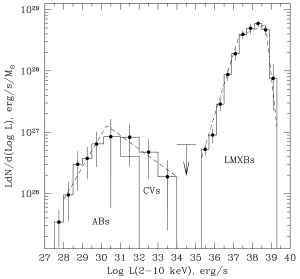|
Nearly 400 years after Galileo determined that the wispy Milky Way
actually comprises a multitude of individual stars, scientists using
NASA's Rossi X-ray Timing Explorer have done the same for the X-ray
Milky Way.
The origin of the so-called galactic X-ray background has been a
long-standing mystery. Scientists now say that this blanket of X-ray
light is not diffuse, as many have thought, but emanates from untold
hundreds of millions of individual sources dominated by a type of dead
star called a white dwarf.
If confirmed, this new finding would have a profound impact on our
understanding of the history of our galaxy, from star-formation and
supernova rates to stellar evolution. The result solves major
theoretical problems yet points to a surprising undercounting of stellar
objects.
Scientists from the Max Planck Institute for Astrophysics (MPA) in
Garching, Germany, and the Space Research Institute of the Russian
Academy of Sciences in Moscow discuss these results in two papers
published in Astronomy & Astrophysics.
"From an airplane you can see a diffuse glow from a city at night," said
Dr. Mikhail Revnivtsev of MPA, lead author on one of the papers. "To say
a city produces light is not enough. Only when you get closer do you see
individual sources that make up that glow — the house lights, street
lamps and automobile headlights. In this respect, we have identified the
individual sources of local X-ray light. What we found will surprise
many scientists."
X-rays are a high-energy form of light, invisible to our eyes and far
more energetic than optical and ultraviolet light. Our eyes see
individual stars sprinkled in a largely dark sky. In X-rays the sky is
never dark; there is a pervasive and constant glow.
Previous observations could not reveal enough X-ray sources to account
for the "X-ray milky way." This led to theoretical problems. If the
X-ray glow were from hot and diffuse gas, it would ultimately "rise" and
escape the confines of the galaxy. Furthermore, all that hot gas would
need to have come from millions of past star explosions called
supernovae, which would imply that estimates of star formation and star
death were way off.
"X-ray telescopes that can resolve the emission into discrete sources
looked but could not account for more than 30 percent of the emission,"
said Dr. Jean Swank, project scientist for the Rossi Explorer at NASA
Goddard Space Flight Center in Greenbelt. Md. "Many have thought that
the lion's share was truly diffuse, for example, from hot gas between
the stars. Now it seems that it can all be accounted for a combination
of two types of stars."
The new study is based on nearly 10 years of data collected by the Rossi
Explorer and constitutes the most thorough map of the galaxy in X-rays.
The science team concluded that the Milky Way galaxy is indeed teeming
with X-ray stars, most of them not very bright, and that scientists over
the years had underestimated their numbers by perhaps a hundredfold.
Surprisingly, the regular suspects of X-ray emission — black holes and
neutron stars — are not implicated here. At higher X-ray energies, the
X-ray glow arises nearly entirely from sources called cataclysmic variables.
A cataclysmic variable is a binary star system containing a relatively
normal star and a white dwarf, which is a stellar ember of a star like
our sun that has run out of fuel. On its own, a white dwarf is dim. In a
binary, it can pull away matter from its companion star to heat itself
in a process called accretion. The accreted gas is very hot, a source of
considerable X-rays.
At slightly lower X-ray energies, the glow is a mix of about one-third
cataclysmic variables and two-thirds active stellar coronas. Most of the
stellar corona activity also takes place in binaries, where a nearby
companion effectively stirs up the outer parts of the star. That
energizes the stellar analog to solar flares, which emit X-rays. The
science team says there are upwards of a million cataclysmic variables
in our galaxy and close to a billion active stars. Both of these numbers
reflect a major undercounting in previous estimates.
"Like a medical x-ray, the chart of the galactic X-ray background
reveals details of the Milky Way's structure," said Revnivtsev. "We can
see through the whole galaxy and count X-ray sources. This is very
important to astronomers who calculate the lives of stars."
NASA Goddard Space Flight Center in Greenbelt, Md., manages the Rossi
Explorer, which was launched in December 1995.
Revnivtsev M., Sazonov S., Gilfanov M., Churazov E., Sunyaev R.
Further information
 Science News Article Science News Article
 Sky & Telescope Article Sky & Telescope Article
Publications
M.Revnivtsev, S.Sazonov, M.Gilfanov, E.Churazov, R.Sunyaev:
"Origin of the Galactic ridge X-ray emission",
Astron. & Astrophys., in press;
 astro-ph/0510050 astro-ph/0510050
S. Sazonov, M. Revnivtsev, M. Gilfanov, E. Churazov, R. Sunyaev:
"X-ray luminosity function of faint point sources in the Milky Way",
Astron. & Astrophys., in press;
 astro-ph/0510049 astro-ph/0510049
Contact
Dr. Mike Revnivtsev, Max-Planck-Institut für Astrophysik,
Tel. 089/30000-2396, E-mail: mikej  mpa-garching.mpg.de mpa-garching.mpg.de
| 

 mpa-garching.mpg.de
mpa-garching.mpg.de